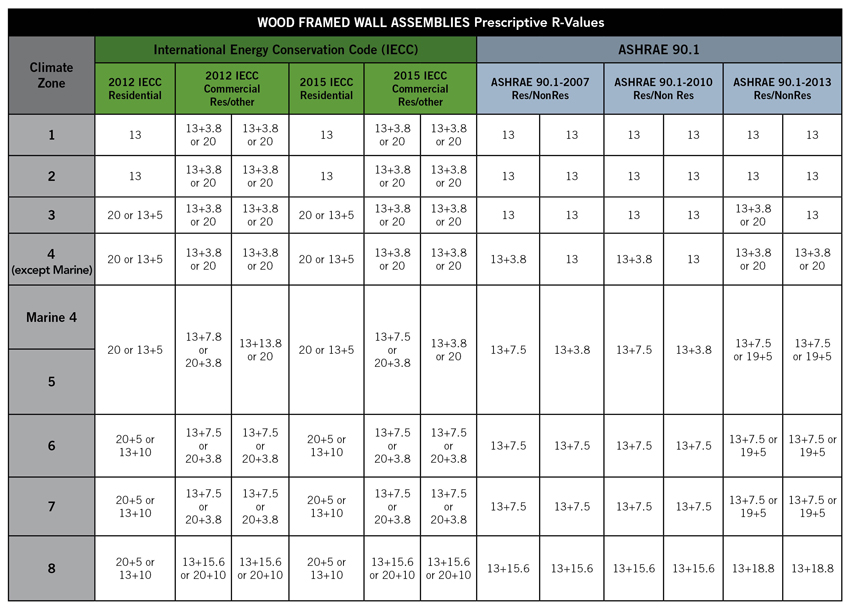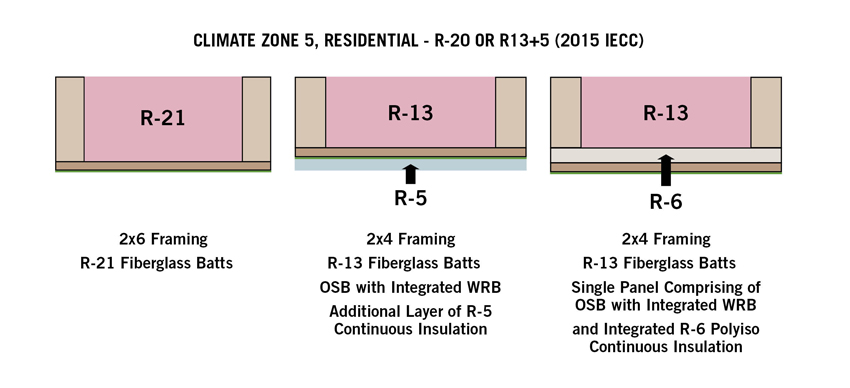Continuous Insulation in Framed Exterior Walls_OLD
How Much Continuous Insulation to Use?
In any given project, the question of how much continuous insulation to use will likely need to be addressed. Determining the minimum code requirements for continuous insulation begins with identifying where to start based on the variables we have discussed in this course. First, the particular building or project needs to be confirmed as either residential or commercial under the IECC, not just under the IBC and IRC. Second, the county where the project is located needs to be confirmed so the appropriately assigned climate zone can be identified. Third, the determination has to be made whether the IECC or ASHRAE 90.1 will be followed as the means to show energy code compliance since they will have slightly different minimums in some cases. Fourth, the choice needs to be made whether the design will meet or exceed all of the specific prescriptive requirements or if compliance needs to be proven using a computerized analysis. Once those four basic determinations are made, the rest will follow from there.

The chart above summarizes the prescriptive R-values for insulation under different versions of the various codes that could be applicable to wood-framed walls. Where two values are shown, the first refers to minimum R-values for cavity insulation and the second refers to minimum R-values for continuous insulation.
Illustrative Examples
To illustrate how this plays out, let’s assume an example project that is a three-story, wood-framed, multifamily building that qualifies as residential under the IECC definition. Further, let’s assume a location in climate zone 5, that the IECC will be followed, and that the goal is to simply meet the prescriptive requirements listed in the code. In this case, we would look to Table R402.1.2 in the residential portion of the IECC to see the criteria that need to be met. There, we would learn that for a wood-framed wall in climate zone 5, we have a choice. This table says we can provide either R-20 insulation in the stud cavities (2-by-6) or we can reduce the cavity insulation to R-13 (2-by-4) if we provide an additional layer of R-5 continuous insulation (R-18 total). In the interest of addressing vapor retarders, we would also look at Table 702.7 of the IRC to see whether a class III vapor retarder is acceptable. Here, we would find that either minimum R-5 CI would need to be provided over a 2-by-4 framed wall or minimum R-7.5 CI would be needed over a 2-by-6 framed wall to allow the use of a class III vapor retarder. In this case, if the 2-by-4 wall with R-13 cavity insulation plus R-5 CI foam were used to meet the thermal insulation requirements, then it would also meet the requirements to drop to a class III vapor retarder. The 2-by-6 wall with only R-20 cavity insulation would still require a class I or II vapor retarder.
Now, let’s consider some variations on this example and see what changes in code requirements. Suppose the owner asks to enlarge the project and raise it up to four stories. It no longer qualifies under the residential portion of the IECC and flips over to the commercial portion. However, as a multifamily building it is still a group R occupancy as defined by the IBC. Hence, we turn to table C402.1.3 and discover that we also have choices there. This table differentiates between group R occupancies and all other occupancies. In some cases, the wall insulation requirements are the same, as in climate zone 4, but since we are in climate zone 5, we discover that the group R requirements are a bit higher than all others. The table shows that we can either provide R-13 insulation in the stud cavities plus R-7.5 CI (2-by-4 framing – R-20.5 total) or provide R-20 plus R-3.8 CI (2-by-6 framing – R-23.8 total), a somewhat more stringent option compared to the R-18 total in the residential portion. If this were a nonresidential use in a different occupancy group, then the requirements would be a bit less stringent at R-13 cavity insulation plus R-3.8 CI (2-by-4 framing – R-16.8 total) or R-20 cavity insulation (2-by-6 framing). Of course, there may be reasons to go beyond the code minimum and still provide a higher level of insulation, but this does illustrate some of the differences between the residential and commercial portions for thermal performance requirements.
As far as vapor retarders and dew points go, however, it doesn’t matter whether the building is residential or commercial. Table 1405.3.2 in the IBC lists the same requirements as Table 702.7 of the IRC for switching from a class I or II to a class III vapor retarder in climate zone 5, namely R-5 CI over 2-by-4 framed walls or R-7.5 CI over 2-by-6 framed walls. In this case, a 2-by-4 wall that meets the thermal requirements of R-13 plus R-7.5 CI will also meet the R-5 requirement for a class III vapor retarder. However, a 2-by-6 framed wall will also need R-7.5 CI to meet the vapor retarder threshold, not just the R-3.8 CI called for to meet thermal requirements only. Hence, it is important to look at both thermal requirements and class III vapor retarder provisions of the codes to determine if there are any differences between the two.
As another variation, let’s assume the three-story building is a prototype that the architect is subsequently hired to modify to suit another location in another state—and a different climate zone. The basic decisions need to be repeated to confirm what does and doesn’t still apply. In this case, it would be residential under the IECC and still be seeking to follow the IECC prescriptive approach, but we discover the building now has to meet the requirements of climate zone 6 instead of climate zone 5. We thus go back to R402.1.2 and find that the wall construction still provides a choice, but the requirements are notably higher. We can still use either R-13 or R-20 insulation in the stud cavities (depending on 2-by-4 or 2-by-6 framing), but continuous insulation is no longer optional since it is required in both cases: R-5 CI minimum with R-20 walls (R-25 total) or R-10 CI minimum with R-13 walls (R-23 total). Clearly, the building location in terms of the climate zone makes a significant difference on the minimum R-values for the insulation.
To determine the choice of vapor retarder in this case, we return to Table 702.7 of the IRC, this time looking at the thresholds for climate zone 6, namely R-7.5 CI over 2-by-4 framed walls or R-11.25 CI over 2-by-6 framed walls. Again, in this case, a 2-by-4 wall that meets the thermal requirements of R-13, plus R-10 CI will also meet the R-7.5 requirement for dropping to a class III vapor retarder. However, a 2-by-6 framed wall will need R-11.25 CI to meet the vapor retarder threshold, not just the R-5 CI called for to meet thermal requirements only. Hence, climate zone continues to influence minimum insulation decisions both in terms of thermal requirements and the use of class III vapor retarders.
Creative Alternatives
As a final variation, let’s assume the design team has come up with a slightly creative approach to the wall assembly that doesn’t exactly meet the prescriptive criteria of the R-value tables. The IECC does have another prescriptive alternative in the form of U-factor tables. This allows the design team to present its calculations for a wall assembly based on achieving an overall U-factor for the assembly. The weighted determinations need to be shown for framing and insulated portions of the walls as in our earlier examples. Since the code does not seek to dictate design or discourage innovation, it naturally allows the same process to be used for any wall construction designs and states the overall U-factor maximums as the prescriptive requirements. In our residential, climate zone 5 example, the maximum overall U-factor that needs to be demonstrated is U-0.06 (equal to R-16.6 overall) per table R402.1.4. It might sound like this is less stringent than the R values we saw earlier, but actually it is not. Keep in mind that in the R-value table, only the insulation is prescribed—it conservatively assumes the rest of the assembly, and if the U-factor calculations were performed for this “assumed” assembly, it would similarly work out to about U=0.06. Therefore, an innovative or alternative wall assembly using the prescriptive U-factor approach would need to achieve a “whole assembly” U-factor of 0.06 or less to be considered compliant. This same process would be applicable if following the commercial portion using Table C402.1.4 with the resulting maximum allowable overall U-factor at a slightly more lenient U-0.064 (equivalent R-15.6).

These wall sections are examples of various ways to meet the prescriptive insulation requirements of the IECC under Table R402.1.2.
Keep in mind that the code is, of course, a minimum requirement. There can be many reasons to exceed this minimum threshold, whether to meet higher standards of voluntary programs such as LEED or simply to boost the overall energy performance of the building as a best practice for building owners. There may also be some practical reasons, too. The IECC examples above refer repeatedly to R-5 and R-3.8 continuous insulation, but if polyiso insulation is used, it would be more prudent to round up to the nearest standard thickness, such as R-6 (1 inch thick) or R-4.5 (3/4-inch thick). Standard offerings will typically be more cost effective than customized ones and, in this case, offer a bit of a safety factor for thermal performance.
Conclusion
Continuous insulation has become part of the mainstream of framed wall construction. Codes and green building standards recognize the significance of it and even require it in many climate zones around the United States. The technologies for providing it have evolved in the past decade or so to allow it to be integrated readily into common construction techniques. There are even combined sheathing products that offer continuous insulation adhered to one side to reduce labor time. Products like these can also influence a reduction in the type of vapor retarder required in a wall assembly. The result is a high-performance, cost-effective, durable, and easier-to-install wall assembly solution.
End Notes
1ICC Evaluation Service Report ESR-3373. June 2015. Web. 12 October 2016. www.huberwood.com/assets/user/library/ESR-3373_(Comb._06-2016).pdf.
Peter J. Arsenault, FAIA, NCARB, LEED AP, is a practicing architect, green building consultant, continuing education presenter, and prolific author engaged nationwide in advancing building performance through design. www.linkedin.com/in/pjaarch

|
ZIP System® building enclosures offer structural and sealing products for a quick rough dry-in. A revolutionary alternative to traditional sheathing and building wrap, ZIP System™ sheathing and tape create a streamlined roof and wall sheathing system with integrated weather and rigid air barriers. The simplified approach to structural roofs and walls helps building teams save time by eliminating installation steps and achieving a quick rough dry-in to accelerate interior work. Backed by a 180-Day Exposure Guarantee and 30-Year Limited Warranty, ZIP System building enclosures not only help keep jobs on track but also provide reliable exterior water management during and after construction. Learn more at InsulateYourBuild.com. |








